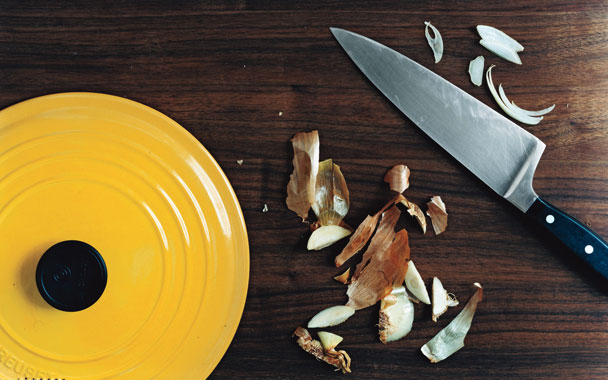I would like to say that it began with the onions, but really it began with the pot, a three-and-a-half-quart Le Creuset cast-iron Dutch oven in bright yellow that I bought last summer when I tossed the Teflon. It was my first piece of French cookware, and having it was like having read Proust—it made me feel French in a leisurely and tidy way, secretly just un peu supérieure.
But the onions themselves were iconic, just six yellow onions in the late winter, still hard and fresh, a couple of bucks a pound, the sort of onions that you knew, just by looking at their tawny paper skins, to be sound and perfectly engineered all the way to the core. Yellow pot plus yellow onions plus winter and that French feeling, of course, linked themselves right to Julia Child, and pretty soon I was home in the kitchen on a gloomy Saturday afternoon, rustling up a pot of soupe à l’oignon. I did it her way—slowly cooking the onions in the sunlike enameled cast iron, first in butter, oil, and their own juices, then with the sugar, then with the flour, watching them darken to bronze and then to deep golden. I was proud of myself, even when I added the organic chicken broth that I hadn’t made (Julia calls for beef broth, but I hadn’t made any of that either). At dinner, the gratin (Gruyère) bubbled up beyond gold, almost oaken, and I felt exquisitely cosmopolitan, which is why I couldn’t bear to throw the soup away or even to eat it as leftovers.
I preferred to revisit my accomplishment on Sunday night, this time as a chicken vegetable soup. Nous were no longer quite français, though, because while I did introduce the mushrooms and the chunks of breast meat, I also added slivers of garlic, frozen peas (which I admit I came to regret in the end), and thin disks of yellow fingerling potatoes, which I always associate with Russia, or at least far northeastern Germany, maybe Prussia. For a Mediterranean contrast, I made a tomato, garlic, and basil bruschetta. My partner was intrigued: We hadn’t seen a slab of meat in days, and we were still enjoying ourselves. The pot remained bright and promising. And yet, it seemed, full. It was perplexing in its way.
The yellow pot had taken up residence in the refrigerator, and it looked good there, beside the green label of the milk carton and above the jam jars (raspberry, pear, rum-flavored orange marmalade from Fortnum & Mason). This was getting serious. I could not bring myself to pour such a broth down the sink, not to mention those seductive onions, and so for dinner on Monday, I strained off the broth, thinned it with water, and then divided the vegetables into two parts. I put a cup of the broth and half the vegetables back into the refrigerator. I sautéed the rest of the vegetables in hot olive oil until the moisture had evaporated out of them and they were crusty on the bottom. In the meantime, I warmed the broth with half a teaspoon of saffron. From these ingredients, I concocted a saffron risotto garnished with more of the basil I had purchased for the bruschetta. It was a substantial risotto, especially because of the potatoes—even twice-cooked, they remained meaty, infused, I thought, with the flavor of both the chicken and the saffron. Our accompaniment was a salad of Bibb lettuce with Gorgonzola cubes, bacon, and Champagne vinaigrette. At this point, I would have located us somewhere north of Pisa—but not all the way to Nice.
The saffron (as yellow as the pot, and a good substitute for the pot, when on Tuesday the pot was retired to the kitchen cabinet again) suggested, or perhaps demanded, that I wander farther afield. I investigated the cupboards and came up with slivered almonds and coconut, which soon evoked Madhur Jaffrey in my mind—and chicken korma. Back to the market for chicken, yogurt, chiles. The remaining onions from my earlier purchase were at my fingertips. Chicken korma is a time-consuming recipe, so, for the rice, I simply cooked up some white basmati, and swirled the leftover saffron risotto into it. I have to say the fingerling potatoes were still holding up, but the peas were looking a little wan and unattractive. Chicken korma is always rich and satisfying, though.
By Wednesday, what remained of the original onion soup wasn’t exactly promising—just a congealed mess of vegetables in a bowl, which was sitting beside a leftover steamed artichoke. The key, in the end, was the Gruyère. When I unwrapped it, it had that bright creamy look that said quiche. So I made my favorite crust, diced up the vegetables—including the artichoke bottom—shredded the cheese, and chopped some basil. On top, I arranged six cooked shrimp in a wheel, to make the quiche look as though it had a reason to exist beyond my goal of finding a home for the last of the onion. And it did. When we ate it for lunch with ciabatta dipped in leftover vinaigrette, it was delicious, especially those potatoes.
But now there’s a big bag of pink shrimp in the freezer, calling out to the yellow pot.

